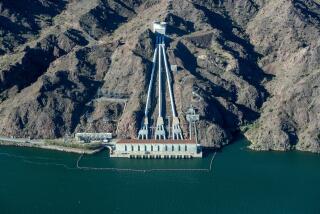Great Lakes and River States in a Stand-Off Over Diversion of Water
- Share via
DETROIT — In a drought, water is power.
No wonder, then, that one of the nation’s biggest power struggles in this hot, dry season is over who controls the plug at the bottom of the Great Lakes.
That power struggle was heating up Friday both in the Midwest and in Washington.
On one side stood seven of the eight Great Lakes states, which border 90% of America’s surface fresh water.
On the other side were the Midwestern and Southern states in the parched Mississippi River basin, where shipping traffic has been all but halted because of record low water levels. This week, perhaps 3,000 barges were reported to be stranded along the river.
Officials of the river states--supported by Illinois, a wild card in the dispute since it is both a river and a lake state--want to pull the plug on the Great Lakes at Chicago.
There, the old Chicago Sanitary and Ship Canal connects Lake Michigan with the inland Illinois Waterway and, eventually, the Mississippi River. The flow between the lake and river systems is controlled by canal gates. Those who want more water released to the rivers argue that it would help refloat ships as far south as Vicksburg, Miss.
In Washington on Friday, a group of 13 Midwestern and Southern senators sent a letter to President Reagan, calling on him to order the U.S. Army Corps of Engineers to more than triple the volume of water released from Lake Michigan to the inland river system.
Senators from across the Great Lakes region rushed to oppose such presidential action.
“You want to be good neighbors, but you have to be concerned about your own constituency as well,” Sen. Howard M. Metzenbaum (D-Ohio) said. “I do not believe (water diversion) would be of that much help, anyway. We’re kidding ourselves if we believe this is the answer.”
At a press conference, Michigan Gov. James J. Blanchard denounced the attempt to win presidential approval of the water diversion, and Michigan Atty. Gen. Frank Kelly threatened court action if there is an attempt to unplug the lakes.
Illinois Gov. James R. Thompson has asked the Corps of Engineers to use its authority over navigable inland waterways and increase the diversion for 100 days, but diversion of Great Lakes water has historically been restricted by a U.S. Supreme Court ruling. In addition, a 1986 federal law requires that any increase in the diversion must have approval of all the Great Lakes governors.
Illinois officials argued that those legal limits were only to prevent Illinois from using lake water for its own consumption and should not prohibit a temporary, emergency effort to aid river navigation. Corps of Engineers officials said they are considering the Illinois request.
Officials of the Great Lakes states contend that more lake water would do little to ease the crisis on the Mississippi, where the water level has fallen as much as 20 feet in some places. Increasing the diversion from the present 3,200 cubic feet per second to 9,000 or 10,000 feet per second would raise the level of the Mississippi at St. Louis by just one foot in 13 to 14 days, according to Corps of Engineers estimates cited by Great Lakes officials.
Yet officials from the river region would be happy to see even that modest increase. “We do have the option to do something more than pray for rain,” Sen. Jim Sasser (D-Tenn.) told a press conference Friday in Washington.
That, however, is just what politicians of the Great Lakes states would recommend. They fear that an emergency release of lake water would set a precedent for arid Sun Belt states to attempt to get the region’s water.
More to Read
Sign up for Essential California
The most important California stories and recommendations in your inbox every morning.
You may occasionally receive promotional content from the Los Angeles Times.










